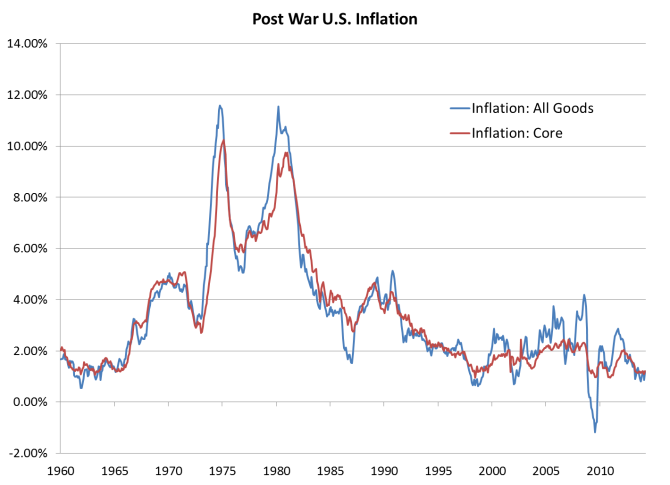Paul Krugman responds to my earlier post. He has a lot to say that’s worth commenting on. I think we actually agree on quite a bit though there are points where we disagree. Let’s take a look. (Paul’s comments in italics).
As I see it, we [i.e., Keynesian macroeconomists] have a general proposition — most recessions are the result of inadequate demand.
I basically agree with this though I admit that I don’t have a particularly clear definition of what we really mean by “aggregate demand.” I think often this is meant to capture changes in consumer sentiment, fluctuations in government demand for goods and services or other incentives to purchase market goods – incentives which would include tax subsidies, monetary stimulus, … etc.
[…] we have a pretty good model of aggregate demand, and of how monetary and fiscal policy affect that demand. That model is IS-LM, with endogenous money as appropriate.
Again I basically agree, with the caveat that the IS-LM model is at most just a sketch. The consumption block of the IS-LM model is much better treated by a modern consumption demand component augmented suitably with credit constraints, some hand-to-mouth behavior and perhaps some myopia. The investment block needs some serious work. My own sense is that it is also much better handled with a modern formulation rather than a simple relationship between investment and the real interest rate. I would also stress that while the IS-LM sketch is pretty good as it stands, it desperately needs to incorporate a serious treatment of the financial sector. In a sense there is a third market / third curve missing from the model – one which gives the interest rate / loan terms faced by consumers as a function of collateral, net worth, etc. We would then get a lot closer to a sketch which could capture important elements of the financial crisis. (See below for a more precise description.)
We do not have an equally good model of aggregate supply.
I completely agree.
What we have, instead, is an observation: prices and wages clearly are sticky in the short run, and maybe for longer than that. There’s overwhelming evidence for that proposition, but in trying to justify it we engage in various kinds of hand-waving about menu costs and bounded rationality.
On the evidence I am again in complete agreement. I actually think Paul is being too dismissive of the justifications for why we see price and wage rigidity. Macroeconomists have invested a huge amount of time and energy into studying price setting behavior and these studies give a pretty clear picture of what is going on at the “micro level.” It’s not just hand-waiving. Paul continues…
we can […] be fairly sure that expansionary policies in a depressed economy won’t be inflationary, and we can use the pretty good demand side model to tell us that monetary expansion won’t work but fiscal policy will when we’re at the zero lower bound.
I sort-of agree with this. Certainly if the interest rate is zero then conventional monetary expansions won’t do anything. Whether government stimulus is a good move is unclear. I am sure that government spending increases employment and output to an extent but it is very important how the money is spent. In an earlier post I argued that even in a severely depressed economy, there is rarely a good justification for spending on projects that aren’t socially valuable. In all likelihood the best fiscal policies will involve some sort of transfer (like payroll tax cuts) or other tax cut rather than government spending.
What the data actually look like is an oldfashioned non-expectations Phillips curve.
OK, here is where we disagree. Certainly this is not true for the data overall. It seems like Paul is thinking that the system governing the relationship between inflation and output changes between something with essentially a vertical slope (a “Classical Phillips curve”) and a nearly flat slope (a “Keynesian Phillips Curve”). I doubt that this will fit the data particularly well and it would still seem to open the door to a large role for “supply shocks” – shocks that neither Paul nor I think play a big role in business cycles.
Paul ends his post with some bait. He writes “it remains true that Keynesians have been hugely right on the effects of monetary and fiscal policy, while equilibrium macro types have been wrong about everything.” OK, I’m again going to try not to take the bait. Let me just point out that this is a difficult statement to take very seriously. For the most part, the Keynesians are a subset of the equilibrium types. Moreover, there are many “equilibrium types” who are not Keynesian but who are instead finance guys who played a crucial role in analyzing the economy during the crisis. I presume he is taking an obligatory shot at Minnesota / Sargent / Lucas / Mathematical modelling etc. but …. I’m not taking the bait.
APPENDIX: The traditional IS-LM system is something like this:
Y = C(Y,r) + I(r) + G +NX(e)
r = max{-π, aY + b(π) }
the first equation is the IS curve governing the goods market. Consumption demand is increasing in Y and decreasing in r. Investment demand is decreasing in r and Net Export demand is a function of the (real) exchange rate. The second equation is the LM curve which I have written as a Taylor rule with the restriction that the nominal interest rate (i = r – π) is subject to the ZLB.
A simple improvement over this system would be to introduce a different borrowing rate for firms and households – call this rate R. R is equal to the base rate r plus an “external finance premium.” The EFP could be a decreasing function of asset values A and income Y. We now have the modified system
Y = C(Y,R) + I(R) + G +NX(e)
r = max{-π, aY + b(π) }
R = r + EFP(Y, A)
I’ll call the third equation the FE curve since it provides a condition for financial market equilibrium. This model will have a spread R-r which will reflect financial stress. Of course the IS-LM-FE system is again just a sketch. We still have no explicit role for liquidity, solvency concerns, bank runs, etc. and the FE block would need to be fleshed out. In fact this model is essentially a static sketch of the financial accelerator model by Bernanke, Gertler and Gilchrist 1999.


